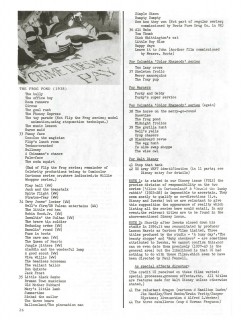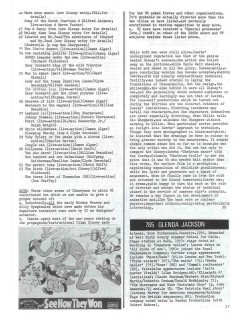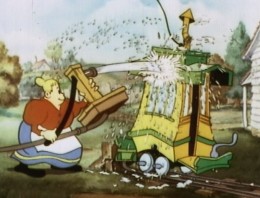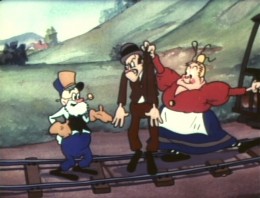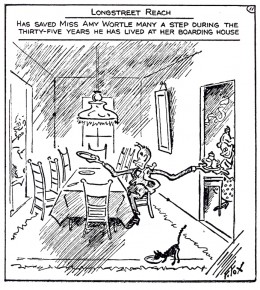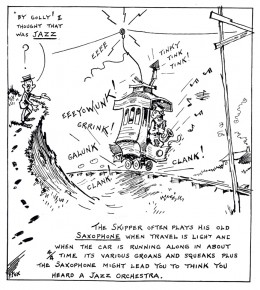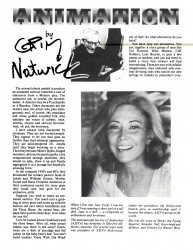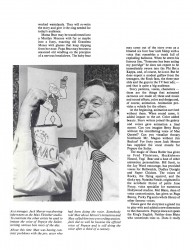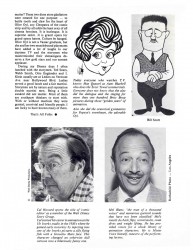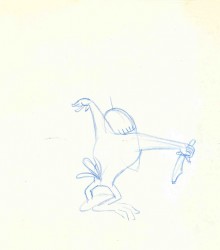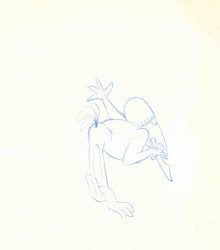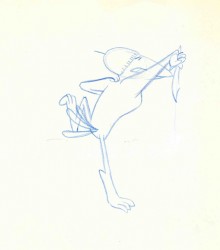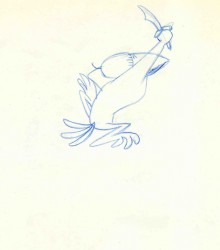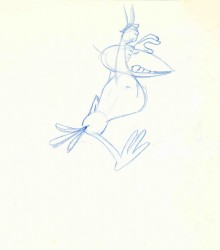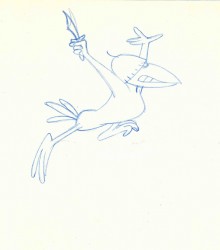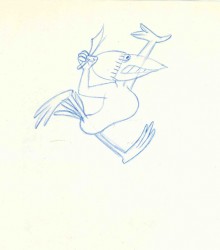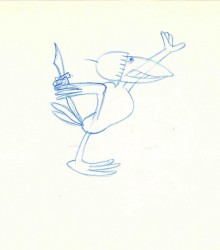Category ArchiveAnimation Artifacts
Animation Artifacts &Daily post 27 Jun 2006 08:25 am
Film Dope
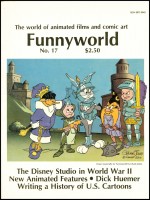 – Magazines are very important to me. The most treasured, unfortunately, do not publish anymore. There are these two that have given me such amazing information and insight that I will always treasure them.
– Magazines are very important to me. The most treasured, unfortunately, do not publish anymore. There are these two that have given me such amazing information and insight that I will always treasure them.
- I have about half a dozen issues of Michael Barrier’s Funnyworld magazine, and I hoard them all preciously. The magazine was the first I’d found to value animation as a real art and give critical information about the films and the form.
Fortunately, Michael Barrier continues to post articles, reviews and invaluable information on his website. I can also reread Funnyworld articles. I value his writing and insight.
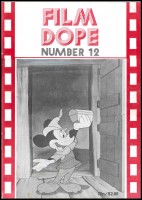 – Right in line with Funnyworld was the British publication Film Dope. This magazine printed an alphabetical listing of film makers, and people important to films. Actors, cinematographers, directors, costume designers, musicians and cartoonists all were blended together in alphabetical order, and one-by-one their careers were offered and analyzed. A formidable chronology of their work was detailed and a short critical commentary was printed.
– Right in line with Funnyworld was the British publication Film Dope. This magazine printed an alphabetical listing of film makers, and people important to films. Actors, cinematographers, directors, costume designers, musicians and cartoonists all were blended together in alphabetical order, and one-by-one their careers were offered and analyzed. A formidable chronology of their work was detailed and a short critical commentary was printed.
Until 1996, the magazine was published on poor paper in a lackluster printing method, but the material was always spectacular. Wonderful scholarship and solid information was the norm. (Only once did I locate an error or oversight in their catalogue. Not that I’m the greatest arbiter.) Their opinions were often a bit ascerbic, but they usually had significant points to make, and I always enjoyed the writing style.
To give an indication of the magazine, I’m posting the entry for Ub Iwerks. About the only place to find back issues is on Ebay.
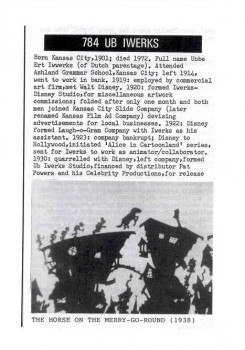
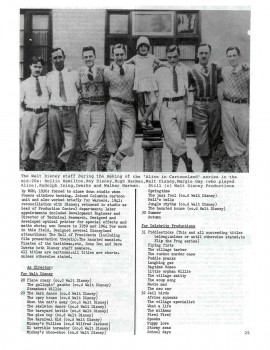
(Click on any image to enlarge and make it readable.)
The magazine was packed from inside cover to inside cover with such material. No ads.
Current magazines that I love are few, too. I have a hard time getting through a week without The New Yorker magazine. I also love Amid Amidi’s Animation Blast and wait patiently for each issue knowing there will be a payoff. Both thankfully still exist.
Animation &Animation Artifacts 25 Jun 2006 07:39 am
Babbitt Runs
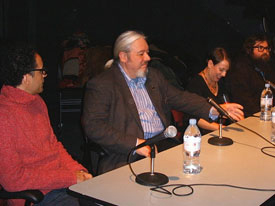 – AWN has an interesting (though somewhat dated) article about a seminar held at School of Visual Arts to hear what came of some of its more luminous animation graduates.
– AWN has an interesting (though somewhat dated) article about a seminar held at School of Visual Arts to hear what came of some of its more luminous animation graduates.
(pictured) Tom Sito, John Dilworth, Yvette Kaplan, Chris Chris Prynoski and Alex Kupershmidt responded to questions which were compiled by AWN writer, Joe Strike.
The program was part of an exhibit of art by the ex-students of SVA. I reviewed the art and the opening here though I didn’t get to the seminar.
- I’d also recommend everyone go to Oscar Grillo‘s blog. He has some beautifully drawn images of his take on some classic comic strips. I’d love to see some animated film versions of the characters as they look here. This man is an artist.
- On my Lou Bunin posting, Mark Mayerson asked: “Somewhere I remember seeing a drawn walk cycle of a dodo bird that Art Babbitt did for Bunin’s feature.”
The answer came from Mark Harding: “The Babbit cycle is on page 189 of Shamus Culhane’s Animation, From Script to Screen.”
I thought I’d post these two pages from that book. There are two more of these studies for Bunin’s film, and the book includes an enormous wealth of other animation referential material. It’s a must-own for animation fans.
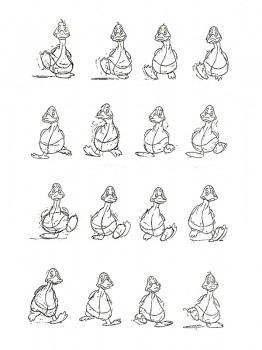
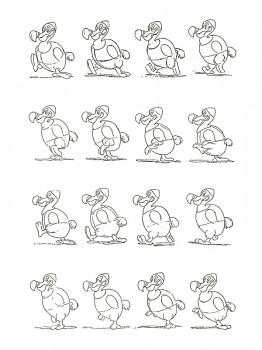
(Click either image to enlarge.)
Animation Artifacts &Trnka 23 Jun 2006 08:08 am
Graphis Trnka Article
To continue with my interest in animators that leave fingerprints, I return to the father of all puppet animators, Jiri Trnka. I have this Graphis Magazine article from 1947. This was published before any of the great Trnka films: The Hand, Archangel Gabriel and Mother Goose, Midsummer’s Night Dream.
Regardless, there are still some beautiful images in his earlier work.
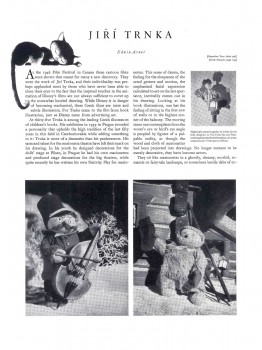
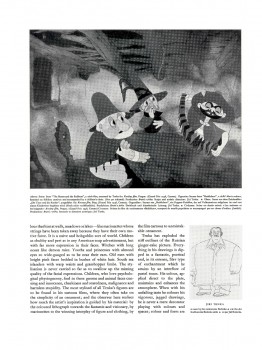
(Click on any image to enlarge.)
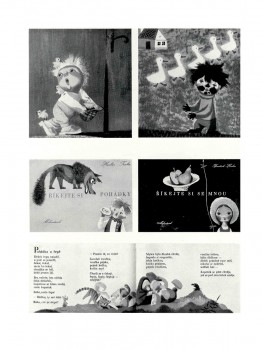
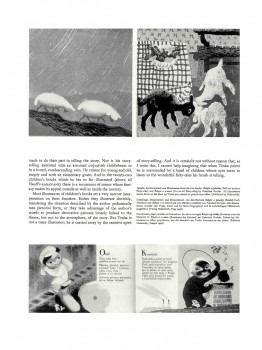
(Note: Graphis printed in three languages; all of the English is included.)
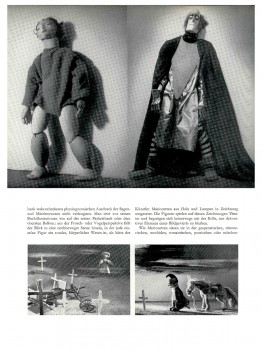
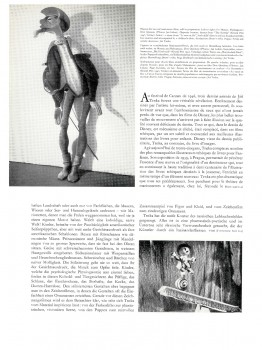
Animation Artifacts &Comic Art 22 Jun 2006 07:23 am
The Toonerville Trolley
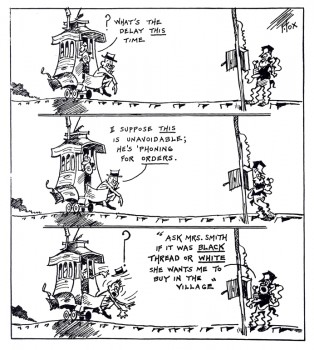
- I’ve been a big fan of the “Toonerville Folks” for a long time. I didn’t find the strip for a while. When I was young, a local TV channel, an ABC subsidiary, ran a lot of old silent Aesop’s Fables. They had classical music backing them up; usually Bizet filled the bill.
One year they upgraded by throwing a number of the Van Buren shorts in betwen the Terry silent films. These Van Buren films, many of them directed by Burt Gillette or Tom Palmer, were odd. There were a number of films with Greek gods as their stars. Then came the shorts with Molly Moo Cow and those with the Toonerville Trolley characters.
(Click on any image to enlarge.)
I liked these and learned from the credits that they were adapted from a comic strip by Fontaine Fox. So, I sought out the comic. Of course, in those days, prior to computers, all you had was the library to research things. My local branch had only one or two examples of the comic strip which ran from 1915 through 1955.
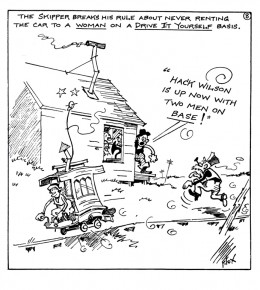
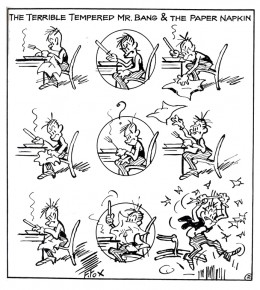
The animated shorts were made in the mid-thirties when Van Buren tried a run to improve their films. Neither sound and color nor the acquisition of the rights to this strip didn’t help; even the “terrible tempered Mr. Bang couldn’t help.” The studio closed before the decade had ended.
In 1978 I worked with R.O. Blechman as his Assistant Director to put together the PBS show, Simple Gifts. This was a packaged of six segments adapted around Christmas with a number of different illustrators designing the segments. One of them, the one I was most attracted to was The Toonerville Trolley. Blechman bought the rights from King Features (at an enormous price) for a four minute film in the middle of the program. I’d worked hard to get the piece to animate. I even did a one minute sample of the film in my off time at night, and I thought it was pretty good. However, Blechman was afraid of losing me in the operation of his studio. (We were doing more commercials than show, and I hated it.) Bill Littlejohn did a nice job of animating the entire piece which was completely subcontracted out to him. That was probably appropriate since Bill worked at Van Buren when they produced these shorts.
Animation Artifacts 20 Jun 2006 09:44 am
Beginnings
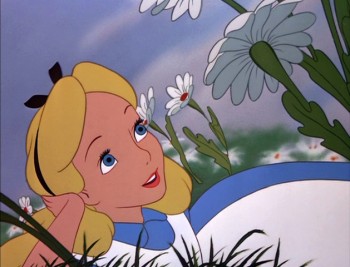 - In the past week I’ve seen a number of animated films. Cars is the only one I saw in a theater. On television, my television, there were a lot of other films: Robots, The Incredibles, Lady & the Tramp, one of those Bugs Bunny compilation things, and Toy Story. On dvd I watched: the complete Norstein, about ½ of Raggedy Ann & Andy, some old Hubley commercials, and the opening of Bambi.
- In the past week I’ve seen a number of animated films. Cars is the only one I saw in a theater. On television, my television, there were a lot of other films: Robots, The Incredibles, Lady & the Tramp, one of those Bugs Bunny compilation things, and Toy Story. On dvd I watched: the complete Norstein, about ½ of Raggedy Ann & Andy, some old Hubley commercials, and the opening of Bambi.
(Quiet)
That’s a lot of animation to watch. Some of it was accidental, some of it was on purpose. Most of the films just showed up on tv, and I watched. However, I thought of something while watching Cars and was curious to follow up on some of the others.
Back when I was a teenager, after viewing a lot of animated features, I realized something. My favorite part of most of these films happened within the first fifteen minutes or so. I particularly loved the openings, the introductions to the characters.
Snow White until she finds the dwarfs’ cottage; Bambi born in the woods; Pinocchio as a puppet until that magnifecent shot of the village wakening; Lady as a pup up to the point where she scorns the Tramp (even that great introduction to the rat); that great intro to all of the characters in 101 Dalmatians right up to the Twilight Bark. I could go on for a while.
It’s true, even of non-Disney features: Hoppity comes home to a torrent of trouble happening amongst the other bugs in Mr. Bug Goes To Town; Gulliver‘s landing and that great tie-him-up sequence; the intros of Hans & Kay & the Snow Queen in the Universal-Americanized version of The Snow Queen; Magoo and his nephew meeting other principle chartacters in 1001 Arabian Nights. Ok, maybe Im pushing it now.
But you get my point. Those quiet, unassuming introductions were just so delightful. We were given some real screen time to get to know all of the important characters,
and they were wonderfully developed before the story really started to unveil.
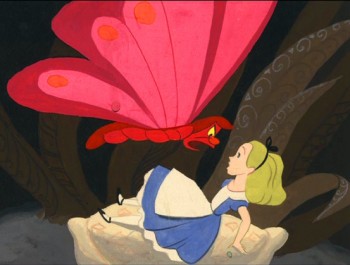 Today we’re thrown hard-core into a film. After the powerful Lion King opening – those first four minutes or so – everything has changed. Like TV shows, you have to get the attention of all the little buggers out there. (Forget the fact that they paid to see the film and are trapped in a theater, many of the kids are going to watch the show on tv anyway.)
Today we’re thrown hard-core into a film. After the powerful Lion King opening – those first four minutes or so – everything has changed. Like TV shows, you have to get the attention of all the little buggers out there. (Forget the fact that they paid to see the film and are trapped in a theater, many of the kids are going to watch the show on tv anyway.)
.
(Not so quiet.)
.
I think Toy Story does it well; they’re loud and fast-paced, but we get to know a lot of the characters in the nursery before the adventure begins. I also liked Robots; it gives us a nice gentle opening really reinforcing the lead character and his family. We don’t meet the louder, more violent characters until our hero gets to the city. Cars starts off with a high tension couple of shots happening inside Lightning McQueen’s head, with his voiceover, then the tension really starts. Or at least it’s loud and fast-paced. We’re sort of thrown into the movie. The world of Pinocchio and Lady & The Tramp is left far behind. Probably not better or worse; it’s just different.
- Lane Smith has a funny pre-4th of July posting today on the site for his book, John, Paul, George & Ben.
- I’ve come to enjoy checking in with Ward Jenkins‘ site. He has such a sweet and gentle personality (as comes across in his blog, at least) that I usually end up smiling after reading it. Today’s posting is one of those times. I also love the very personal touch he brings to it.
- In a completely different way, I enjoy Eddie Fitzgerald‘s blog. His story of his first animation job is funny, revealing, and reminded me of some of my first days.
- Jim Hill Media has an interesting article about the box-office take of Cars. Is too much being made of box-office take these days? Should we be more concerned about the “artistry” of these films?
Animation Artifacts 16 Jun 2006 08:01 am
On-line viewing
Thad of Animation ID has posted a number of cartoons of interest: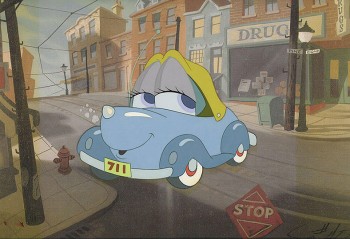 –
–
- The Tex Avery short One Cab’s Family tells the story of a family of cars with a hot-rodder amongst them. This short offers beautiful design, excellent direction, good story, great track.
I often wondered which film influenced the other: this or Susie The Blue Coupe. Both done in 1952. Both look similar, though the Disney film is lusher. Those windshields for eyes.
(Susie The Blue Coupe – thanks to Cuckoocomics.)
- Larry Doyle produced a series of shorts using the Warner Bros. characters as if they were in a TV sitcom. I’m not sure that actually was the plan when they were made.
Deliciously unfunny. Completely unwatchable. You can try if you like.
Thanks to Thad for posting them. I otherwise might not have seen the minute I watched.
- There’s an interesting biography of Charles Dickens animated by the Rufflebrothers for the BBC at Bleak House. This is the site for the BBC live action drama, Bleak House, and the flash animated piece gives an idea of Dickens’ life. It’s an on-line accompaniment to the series. I think the animated piece stands up on its own, although it gets a bit dry.
Aardman animation has just sold their Big Jeff shorts to MTV2 for airing starting late June. You can get a sample of these shorts at Big Jeff.com.
Animation Artifacts 15 Jun 2006 08:12 am
Grim Voice
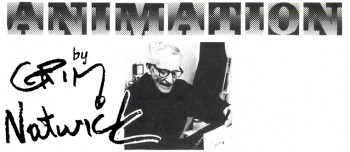 - Today’s guest writer is Grim Natwick. This is a short-lived column Grim Natwick wrote for Cartoonist Profiles magazine.
- Today’s guest writer is Grim Natwick. This is a short-lived column Grim Natwick wrote for Cartoonist Profiles magazine.
This particular one was printed June 1980. It’s an article about cartoon voices.
(Click on any image to enlarge.)
Here are a couple of interesting links:
- Thanks to Drawn, here’s a link to a collection of Bill Mauldincartoons.
- There’s a entertaining video of a “Rube Goldberg” machine made of sticks, stones and leaves at Make:Blog
Animation Artifacts 14 Jun 2006 07:19 am
Marty Taras/More Fritz
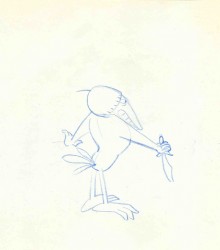 – No, these aren’t drawings from a Heckle & Jeckel cartoon; it’s a Marty Taras scene from Fritz The Cat. I thought I’d post some more bits from one of the scenes I have. It’ll give you an idea of the clean/roughs that Marty drew.
– No, these aren’t drawings from a Heckle & Jeckel cartoon; it’s a Marty Taras scene from Fritz The Cat. I thought I’d post some more bits from one of the scenes I have. It’ll give you an idea of the clean/roughs that Marty drew.
His work was always drawn this way, very clean leaving easy work for the assistant. A number of animators I worked with had a similar drawing style. Johnny Gentitlella and Earl James both had drawings very much like this. Nick Tafuri‘s style was broader, but most of the drawings had the same look. This was the look of the Terrytoons/Paramount material. If an animator drew too rough, then the assistants had to work harder, and it ended up costing the producers more money. The animators adapted.
#1 (Click any image to enlarge to see full pages.)
Animation Artifacts &Fleischer 11 Jun 2006 07:40 am
Hoppity Songs
– Finishing off my short series on sheet music, for now, I have a non-Disney cover. It’s the 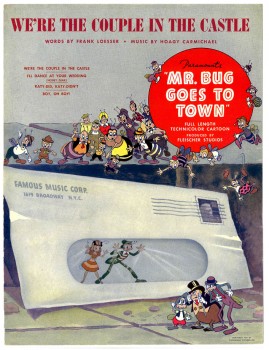 sheet music for the 2nd feature film from the Fleischer’s, Mr. Bug Goes To Town.
sheet music for the 2nd feature film from the Fleischer’s, Mr. Bug Goes To Town.
This was a feature that really got me going when I was young. I think it was the first original story done in animation; not an adapted fairy tale or novel. The story still works for me, though it comes off as a bit episodic. (Actually, I think most animated features are too episodic.) They’ve created a complete world for these insects, and it works.
Technically the film is a bit limited. The opening title shot is a stunning shot panning down the Empire State Building and across NYC ending on the vacant lot where the bugs live. The animation is adequate for the period; it has a charm that I find delightful and sometimes exciting. The voices are good, and the music is excellent.
(Click images to enlarge.)
This was the hit song, written by the brilliant Hoagy Carmichael (who wrote Stardust, Heart and Soul, and Skylark) and the just-as-brilliant Frank Loesser (who wrote Guys and Dolls, Hans Christian Andersen, and How To Succeed In Business). The score for the film was co-written by Leigh Harline (who scored Pinocchio, a lot of Disney shorts, and The 7 Faces of Dr. Lao, among others).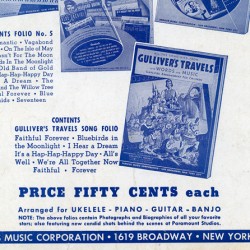
As we’ve seen with the last two postings, most sheet music was printed with one or two colors )red for Der Fuehrer’s Face, brown & green for Song of the South) as opposed to full color. However, this Fleischer song has a full color cover (although they use one color on the rear cover). It shows that Paramount felt they had a hit song here, and they did have a modest hit. Glenn Miller’s recording of it didn’t hurt.
The rear cover is little more than an ad for other Paramount songs. However, in among the group is Gulliver’s Travels. I’m posting just this small section of the back cover, printed in blue.
Animation Artifacts 10 Jun 2006 07:59 am
Song of the South Music
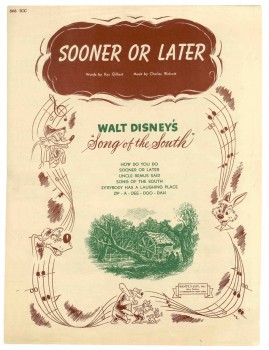
- To continue with the graphics on sheet music, the music for Song of The South, in the 1940′s wasn’t quite as dynamic as the one I posted yesterday, Der Fuehrer’s Face.
This cover tries to capture the lyrical, romantic feel of the film. Here surrounding the live-action plantation, with all the different songtitles available from the film in the sky, is a border consisting of the animated characters from the film. The colors are limited to the green-etched homestead and the brown-linear characters.
The back cover of the sheet music contains a shot of the live-action characters, James Baskett, Bobby Driscoll, and Luana Patten. All are colored in the same brown ink as the cover’s line art.
(Click on images to enlarge.)
That year “Zip-A-Dee-Doo-Dah“, also from this film, won the Oscar, while the music, itself, was nominated for Best Scoring of a Musical Picture.
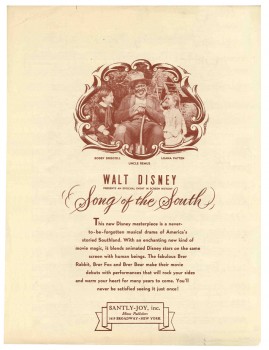 This film made quite an impression on me when I was a kid. And this song was one of the two I played over and over from the record. I also loved “Laughing Place”. It’s something of a shame that the film has been kept out of circulation in the US. I can’t imagine that the film affected me as a child in any negative way. Uncle Remus was clearly the hero of the film and the only truly positive adult character in the film.
This film made quite an impression on me when I was a kid. And this song was one of the two I played over and over from the record. I also loved “Laughing Place”. It’s something of a shame that the film has been kept out of circulation in the US. I can’t imagine that the film affected me as a child in any negative way. Uncle Remus was clearly the hero of the film and the only truly positive adult character in the film.
The last time I saw the film projected was back in the 70′s when Disney set themselves up at Lincoln Center to show a complete retrospective of ALL their films. At the library auditorium behind Lincoln Center there were a number of seminars in which Frank Thomas, Ollie Johnston, Ken Andersen and Woolie Reitherman talked about their work.
I remember Frank Thomas talking about this feature, saying that Disney only did the best for the film hiring the greatest cinemaphotographer, Gregg Toland, to shoot it. He’d shot everything from Citizen Kane to The Grapes of Wrath. (Both are unbelievably stunning works of cinematographic art.) What Thomas didn’t say, or didn’t realize, was that this was Toland’s first COLOR feature. And it showed. Garish, cartoon colors flooded the screen, with actors wearing much too much makeup. A big step for Toland but not the best photography.
Still, I remember those colors vividly, and I would love to see it again – on screen. A dvd would do.
